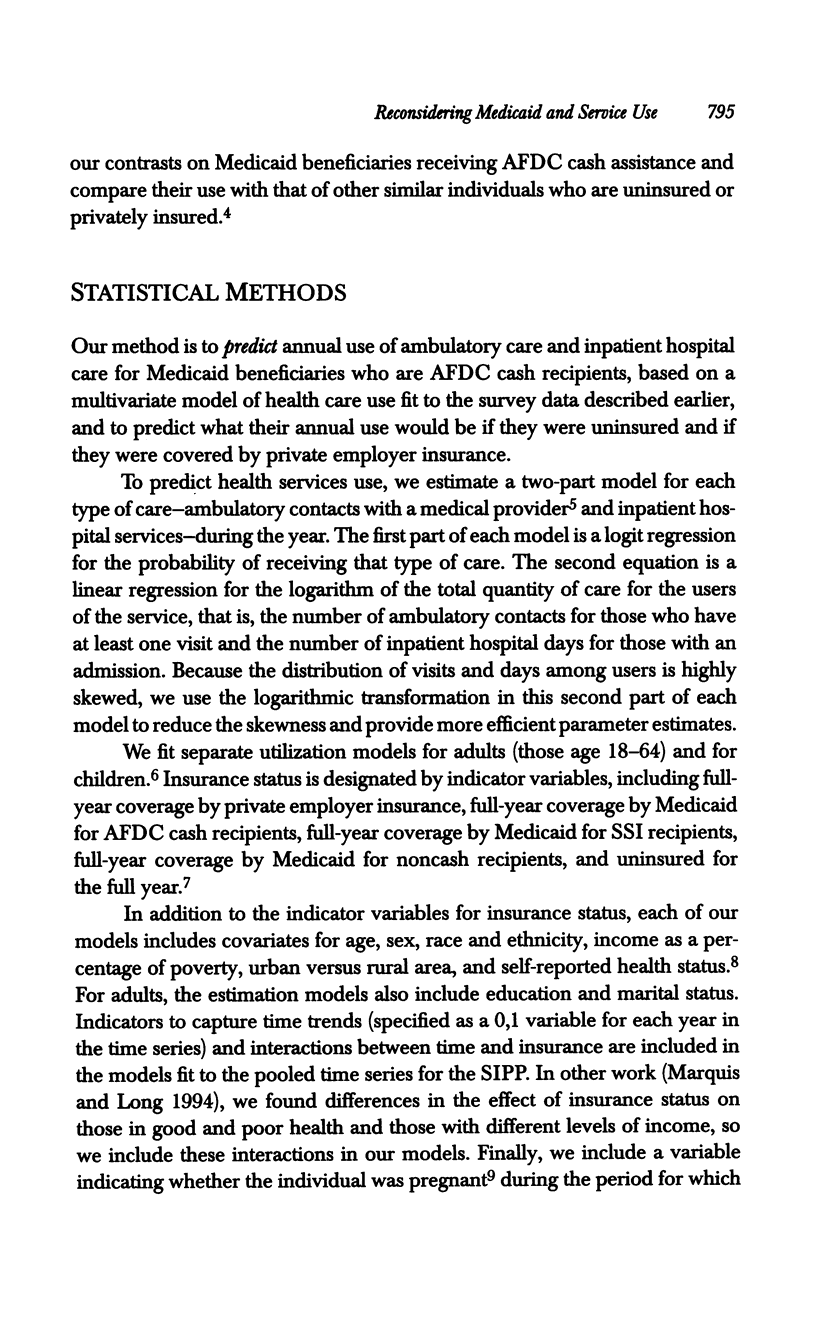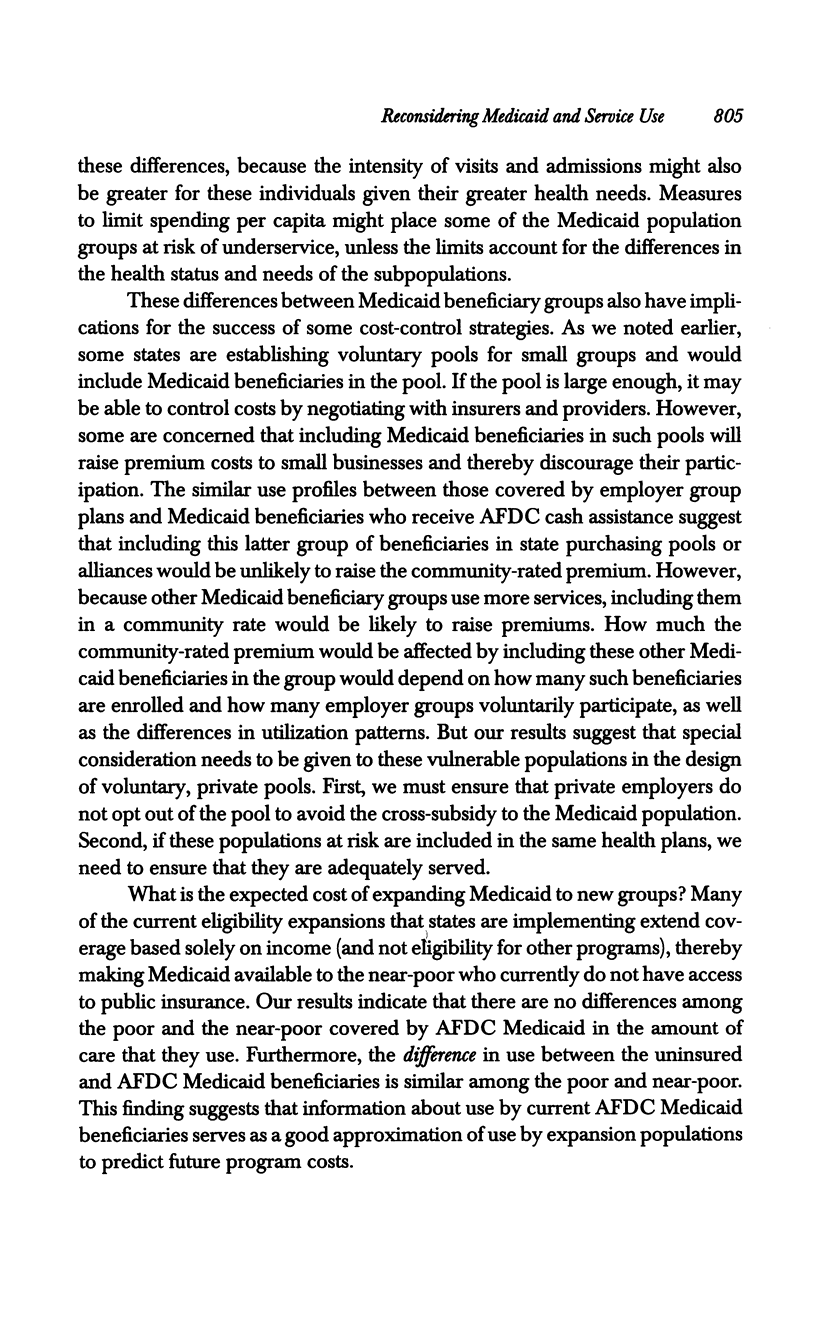Abstract
OBJECTIVE: Our research compares health care use by Medicaid beneficiaries with that of the uninsured and the privately insured to measure the program's effect on access to care. DATA SOURCES/STUDY SETTING: Data include the 1987 National Medical Expenditure Survey and the Survey of Income and Program Participation for 1984-1988. STUDY DESIGN: We predict annual use of ambulatory care and inpatient hospital care for Medicaid beneficiaries receiving AFDC cash assistance and compare it to what their use would be if uninsured or if covered by private insurance. Comparisons are based on multivariate models of health care use that control for demographic and economic characteristics and for health status. Our model distinguishes among Medicaid beneficiaries on the basis of eligibility to account for the poor health of beneficiaries in some eligibility groups. PRINCIPAL FINDINGS: AFDC Medicaid beneficiaries use considerably more ambulatory care and inpatient care than they would if they remained uninsured. Use among the AFDC Medicaid population is about the same as use among otherwise similar, privately insured persons. Use rates differ substantially among different Medicaid beneficiary groups, supporting the expectation that some beneficiary groups are in poor health. CONCLUSIONS: Although Medicaid has increased access to health care services for beneficiaries to rates now comparable to those for the privately insured population, because of lower cost sharing in Medicaid we would expect higher service use than we are finding. This suggests possible barriers to Medicaid patients in receiving the care they demand. Enrollment of less healthy individuals into some Medicaid beneficiary groups suggests that pooled purchasing arrangements that include Medicaid populations must be designed to ensure adequate access for the at-risk populations and, at the same time, to ensure that private employers do not opt out because of high community-rated premiums.
Full text
PDF

















Selected References
These references are in PubMed. This may not be the complete list of references from this article.
- Freeman H. E., Corey C. R. Insurance status and access to health services among poor persons. Health Serv Res. 1993 Dec;28(5):531–541. [PMC free article] [PubMed] [Google Scholar]
- Iglehart J. K. Health policy report. Health care reform. The states. N Engl J Med. 1994 Jan 6;330(1):75–79. doi: 10.1056/NEJM199401063300128. [DOI] [PubMed] [Google Scholar]
- Manning W. G., Newhouse J. P., Duan N., Keeler E. B., Leibowitz A., Marquis M. S. Health insurance and the demand for medical care: evidence from a randomized experiment. Am Econ Rev. 1987 Jun;77(3):251–277. [PubMed] [Google Scholar]
- Marquis M. S., Long S. H. The uninsured access gap: narrowing the estimates. Inquiry. 1994;31(4):405–414. [PubMed] [Google Scholar]
- Rogal D. L., Helms W. D. State models: an overview. Tracking states' efforts to reform their health systems. Health Aff (Millwood) 1993 Summer;12(2):27–30. doi: 10.1377/hlthaff.12.2.27. [DOI] [PubMed] [Google Scholar]
- Rosenbach M. L. The impact of Medicaid on physician use by low-income children. Am J Public Health. 1989 Sep;79(9):1220–1226. doi: 10.2105/ajph.79.9.1220. [DOI] [PMC free article] [PubMed] [Google Scholar]
- Rowland D., Lyons B. Triple jeopardy: rural, poor, and uninsured. Health Serv Res. 1989 Feb;23(6):975–1004. [PMC free article] [PubMed] [Google Scholar]
- Sheils J. F., Lewin L. S., Haught R. A. Potential public expenditures under managed competition. Health Aff (Millwood) 1993;12 (Suppl):229–242. doi: 10.1377/hlthaff.12.suppl_1.229. [DOI] [PubMed] [Google Scholar]
- Short P. F., Cantor J. C., Monheit A. C. The dynamics of Medicaid enrollment. Inquiry. 1988 Winter;25(4):504–516. [PubMed] [Google Scholar]
- Short P. F., Lefkowitz D. C. Encouraging preventive services for low-income children. The effect of expanding Medicaid. Med Care. 1992 Sep;30(9):766–780. doi: 10.1097/00005650-199209000-00002. [DOI] [PubMed] [Google Scholar]
- Swartz K., Marcotte J., McBride T. D. Spells without health insurance: the distribution of durations when left-censored spells are included. Inquiry. 1993 Spring;30(1):77–83. [PubMed] [Google Scholar]
- Wilensky G., Berk M. L. Health care, the poor, and the role of Medicaid. Health Aff (Millwood) 1982 Fall;1(4):93–100. doi: 10.1377/hlthaff.1.4.93. [DOI] [PubMed] [Google Scholar]


